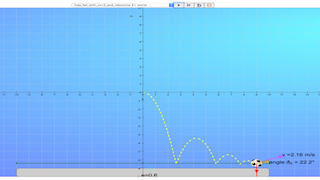About
Topics
Energy formsEnergy conversion
Takeaways:
Energy makes changes and movement possible in everyday lifeEnergy is required to enable things to work or move.
There are different forms of energy and they can be converted from one form to another.
Description
This simulation allow students to explore the concepts of kinetic energy and potential energy. When the re-bounce case is selected, the sum of kinetic energy and potential energy drop immediately after each contact with the ground. The energy loss is typically associated with sound and heat energy loss to the surrounding by the ball.Sample Questions that this simulations was made to address
Sample Learning Goals
**Recognise and give examples of the various forms of energy. - kinetic energy - potential energy**Investigate energy conversion from one form to another and communicate findings.
Version:
- http://weelookang.blogspot.sg/2014/09/ejss-projectile-customized-after.html
- http://weelookang.blogspot.sg/2014/08/brown-bag-in-time-in-tune-lunch-time.html
- http://weelookang.blogspot.sg/2014/05/ejss-projectile-motion-model-for.html
- http://weelookang.blogspot.sg/2013/12/ejss-free-fall-model.html
Translations
| Code | Language | Translator | Run | |
|---|---|---|---|---|
 |
||||
Credits
 This email address is being protected from spambots. You need JavaScript enabled to view it.
This email address is being protected from spambots. You need JavaScript enabled to view it.
Projectile Motion and Energy: A Study Guide
Short-Answer Quiz
Instructions: Answer the following questions in 2-3 sentences each.
- What is kinetic energy, and how is it related to an object's speed?
- What is potential energy, and how does the "ref. PE=0 line" affect its measurement in the simulation?
- Describe the relationship between kinetic energy (KE), potential energy (PE), and total energy (TE) in a system without friction.
- Explain how the graphs of KE and PE change over time when a ball is tossed upwards in the simulation.
- How does the simulation demonstrate the principle of conservation of energy?
- What is work, and how is it related to energy transfer?
- Define power and explain its relationship to work and time.
- What are some common misconceptions students have about energy?
- How does the "free_fall_and_rebounce" setting differ from the "free_fall" setting in terms of energy transformations?
- What happens to the total mechanical energy (KE and PE) when frictional forces are present in a moving system?
Short-Answer Key
- Kinetic energy is the energy an object possesses due to its motion. It is directly proportional to the square of the object's speed (KE = 1/2 * m * v^2).
- Potential energy is stored energy due to an object's position, state, or shape. The "ref. PE=0 line" is a reference level for measuring PE. Changing this line shifts the PE values but does not affect the actual energy changes.
- In a system without friction, the total energy (TE) remains constant. As KE increases, PE decreases, and vice versa, such that KE + PE = TE.
- When a ball is tossed upwards, its KE decreases as it ascends and converts to PE. At the highest point, KE is minimum and PE is maximum. As the ball descends, PE converts back to KE.
- The simulation demonstrates the conservation of energy by showing that the total energy (TE) remains constant throughout the motion, even as KE and PE transform into each other.
- Work is done when a force causes an object to move a distance. The amount of work done equals the amount of energy transferred to or from the object.
- Power is the rate at which work is done. It is calculated by dividing the work done by the time taken (P=W/t). A higher power means work is done more quickly.
- Students may think energy is a substance that flows or a force. They might also believe energy is used up and disappears, rather than being conserved and transformed.
- In the "free_fall_and_rebounce" setting, some energy is lost with each bounce, likely due to sound and heat. This contrasts with the ideal "free_fall" scenario, where TE remains constant.
- When friction is present, some mechanical energy is converted to other forms like heat and sound. This results in a decrease in the total mechanical energy (KE and PE) of the system.
Essay Questions
- Discuss the various forms of energy and provide real-life examples of energy conversions between different forms.
- Analyze the differences between potential energy and kinetic energy, using examples from the Projectile Motion Energy Model simulation.
- Explain the concept of work and power, and discuss how they relate to energy transformations in real-world scenarios.
- Critically evaluate the limitations of the Projectile Motion Energy Model simulation in representing real-life projectile motion.
- Design an experiment using the simulation to investigate the relationship between an object's initial velocity and its maximum height in projectile motion.
Glossary of Key Terms
TermDefinitionKinetic Energy (KE)The energy of motion. KE is dependent on an object's mass and velocity.Potential Energy (PE)Stored energy due to an object's position, state, or configuration. Examples include gravitational PE, elastic PE, and chemical PE.Total Energy (TE)The sum of an object's kinetic and potential energies in a system.Conservation of EnergyThe fundamental principle that energy cannot be created or destroyed, only transformed from one form to another.WorkThe transfer of energy that occurs when a force acts on an object to move it a certain distance.PowerThe rate at which work is done or energy is transferred. It is calculated as work done divided by the time taken.FrictionA force that opposes motion between two surfaces in contact. Friction converts some mechanical energy into heat and sound, reducing total mechanical energy.Reference Line (PE=0)A designated level in the simulation used as a reference point for measuring potential energy. Changing this line affects PE values but not energy changes.
Briefing Document: Projectile Motion and Energy
Source: Excerpts from "Projectile Motion Energy Model - Open Educational Resources / Open Source Physics @ Singapore"
Main Themes:
- Projectile Motion: Exploring the motion of objects launched into the air.
- Energy: Understanding different forms of energy and their transformations during projectile motion.
- Energy Conservation: Investigating the principle of conservation of energy within the context of projectile motion.
- Simulations in Education: Using the Easy JavaScript Simulation (EJS) tool to enhance student understanding of these concepts.
Key Ideas and Facts:
- Energy Forms and Conversion:
- The resource emphasizes the importance of energy for movement and change.
- Different forms of energy are introduced, including kinetic energy (KE) and potential energy (PE), along with the concept of energy conversion between these forms.
- "Energy makes changes and movement possible in everyday life... There are different forms of energy and they can be converted from one form to another."
- Projectile Motion Simulation:
- The resource uses an EJS-based simulation to demonstrate projectile motion and its associated energy transformations.
- Users can manipulate initial conditions like launch velocity and observe changes in KE, PE, and total energy (TE) over time.
- This allows for an interactive exploration of how these energy forms change throughout the projectile's trajectory.
- Investigating Energy Relationships:
- The document includes guided activities using the simulation to investigate energy relationships.
- Students are encouraged to observe and analyze energy graphs for different scenarios (free fall, toss up, etc.).
- Sample questions prompt students to think critically about the connections between KE, PE, and TE.
- For example, "Select total energy te checkbox, suggest an big idea relating ke and pe to te." with the suggested answer being "ke + pe = te."
- Modeling Kinetic Energy:
- The resource guides students to develop a mathematical model for KE based on the simulation data.
- Students analyze how KE changes with the object's speed (v).
- Through observation and data analysis, they arrive at the equation for KE: "suggested answer ke = 0.5*v^2".
- Addressing Misconceptions:
- The document acknowledges common student misconceptions regarding energy, such as thinking of it as a substance or force.
- It emphasizes that work done represents energy transferred, not energy stored.
- This awareness helps teachers address these misconceptions effectively.
- Learning Resources and Extensions:
- The resource provides links to downloadable worksheets and additional EJS simulations.
- This offers teachers a wealth of supplementary material to enhance student learning beyond the initial projectile motion exploration.
Significance:
This resource effectively combines interactive simulations, guided inquiry, and conceptual explanations to teach about projectile motion and energy. By engaging students in active exploration and model development, it promotes deeper understanding and addresses common misconceptions. The use of EJS simulations makes the concepts visually engaging and accessible, enhancing student learning experiences.
Sample Learning Goals


For Teachers
Activity 1
INVESTIGATE
Go to the following simulation: http://tinyurl.com/ast2016-3 
The left panel shows a football being given an initial velocity. This could be zero (the ball is being dropped), upwards (tossed up) or horizontal (thrown horizontally).
The right panel allows you to plot the energy of the object over time. The default is a plot for kinetic energy (ke), but you can also request potential energy (pe), and total energy (te). Remember that you can play the simulation by clicking the appropriate button (►). Click the pause button ( ▌▌) to pause the simulation.
- First select the “free_fall” setting, using the yellow drop-down box in the bottom panel. Watch the ke and pe graphs as the object moves. What do you notice about the graphs?
- suggested answer: kinetic energy increases from t = 0 , KE = 0 J at an increasing rate. Potential energy decreases from t = 0 s, PE = maximum J at an decreasing rate as shown in the sketch.
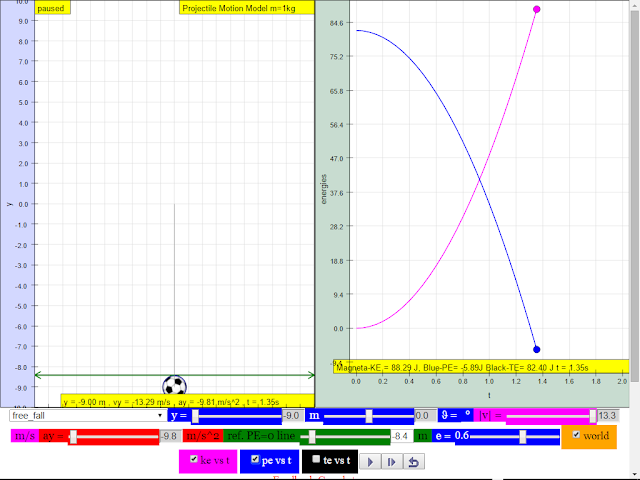
- suggested answer: kinetic energy increases from t = 0 , KE = 0 J at an increasing rate. Potential energy decreases from t = 0 s, PE = maximum J at an decreasing rate as shown in the sketch.
- Now try the “toss_up” setting. How are the ke and pe graphs different?
- suggested answer: kinetic energy decreasing from t = 0 , KE = 50 J at an decreasing rate until t =1 s. From t >1 s, Kinetic energy increases at an increasing rate. Potential energy increases from t = 0 s to 1 s. From t>1 s, PE decreases at decreasing rate as shown in the sketch.
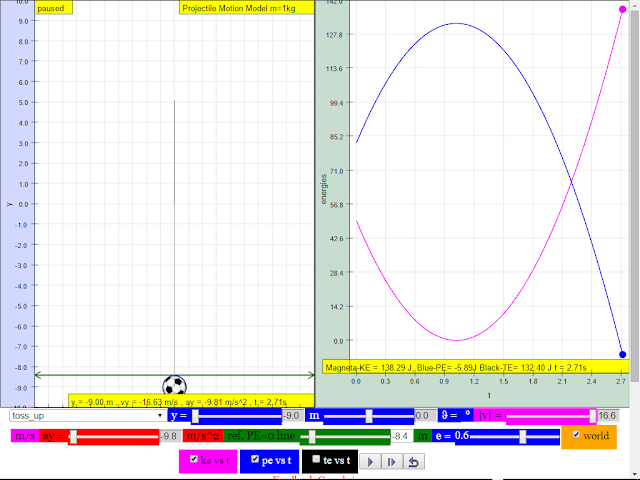
- suggested answer: kinetic energy decreasing from t = 0 , KE = 50 J at an decreasing rate until t =1 s. From t >1 s, Kinetic energy increases at an increasing rate. Potential energy increases from t = 0 s to 1 s. From t>1 s, PE decreases at decreasing rate as shown in the sketch.
- Select total energy te checkbox, suggest an big idea relating ke and pe to te.
- suggested answer: ke + pe = te
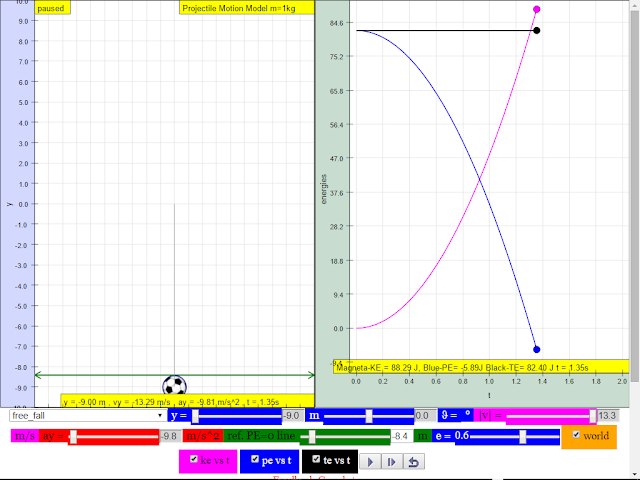
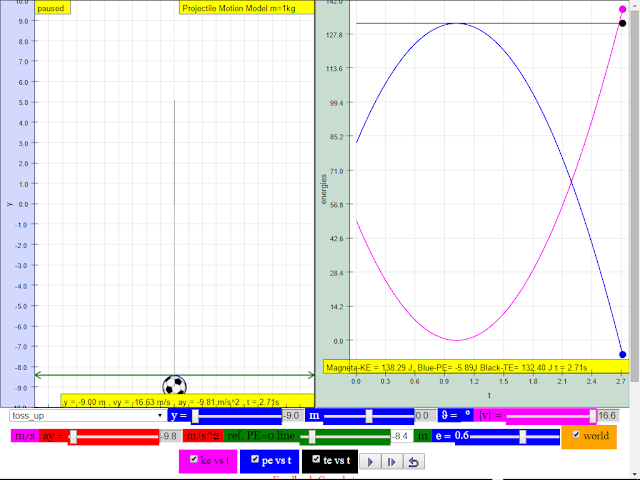
- suggested answer: ke + pe = te
- You can alter the reference line for this simulation. Reset the simulation for “free_fall” or for “toss_up” but, before you press play, change the “ref. PE=0 line” to a different value.
How are the ke and pe graphs different when you choose a different PE reference line?- suggested answer: reference PE = 0 is a imaginary line for which potential energy is calculated referencing from. ke is not affected by “ref. PE=0 line”
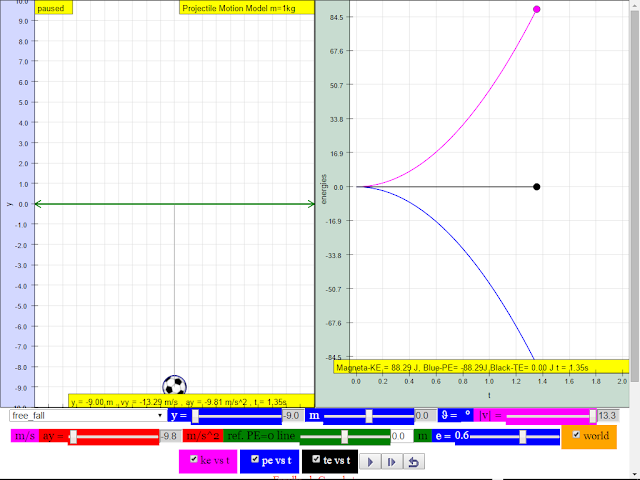

- suggested answer: reference PE = 0 is a imaginary line for which potential energy is calculated referencing from. ke is not affected by “ref. PE=0 line”
MODEL
You may have noticed that the kinetic energy ke depends on the speed |v|. Now set the simulation to “user_defined”. You can choose the speed you want by typing the value in the magenta box in the bottom. You can read the corresponding kinetic energy ke in the yellow box below the graph in the right-hand panel. Try to fill up the table below.
| Speed |v| in m/s | Speed x Speed (v2) | Kinetic energy ke in J |
|
0.00
|
||
|
1.00
|
||
|
2.00
|
||
|
3.00
|
9.00 | |
|
4.00
|
||
|
5.00
|
12.5 |
Now that you have investigated some of the different motions of the football, let’s try to model this by creating some rules about pe and ke. Note that the mass of the ball in the simulation is 1.00 kg, as indicated in the yellow box above the image on the left.
by observing the data is the table, suggest a viable equation-model for ke in terms of v.
suggested answer ke = 0.5*v^2
- Write down some rules for the relationships between pe and ke. Here’s an example:
ke + pe = te
the value of pe is measured from the PE reference line
“The graph for ke does not depend on the PE reference line.”
APPLY
Now try to test your model to see if your rules hold true for a different pre-set motion: “free_fall_and_rebounce”.
- Which of your rules are still the same after trying the “free_fall_and_rebounce” setting?
- ke +pe = te
- the value of pe is measured from the PE reference line
- Which of the rules were not retained?
- ??, ke = 0.5*v^2 is incomplete, the complete equation is ke = 0.5*m*v^2 where m is the mass of the object.
Energy transfers and transformations Key inquiry question:
How can we account for the ‘appearance’ and ‘disappearance’ of energy when objects interact with each other?
1. & 2.Work and power
• Work done is defined as the force x distance moved in the direction of the force.
• When we do work, energy is ‘used up’. The amount of work is equal to the energy transferred or used.
• Power is the rate of doing work and is given by: power = work done / time taken (P = W/t).
3. Potential energy and kinetic energy
• Kinetic energy is the energy a body possesses due to its motion.
• Kinetic energy Ek = ½ mv2 .
• Potential energy is the energy stored in a body due to its position, state or shape (e.g. elastic, gravitational, chemical). Gravitational potential energy is the energy which a body possesses due to its position relative to the ground. Gravitational potential energy Ep = mgh.
• The total mechanical energy (Ek and E p) is conserved if no frictional forces are present in a moving system.
4. Energy conversion and conservation
• Energy is defined as the capacity to do work. Energy is transferred when work is done.
• There are different forms of energy e.g. kinetic energy, elastic potential energy, gravitational potential energy, chemical potential energy and thermal energy.
• Energy can be transformed from one form to another but cannot be destroyed or created (principle of conservation of energy).
Students’ prior knowledge of Energy
Primary level:
Students learn that energy:
• is required to make things work or move and energy from most of our energy resources is derived in some ways from the Sun, our primary source of light and heat energy.
• exist in different forms e.g. kinetic energy (movement energy), gravitational potential energy (objects above the ground), elastic potential energy (spring, elastic band), light energy, electrical energy, sound energy, heat energy and chemical energy (as a form of stored energy: food, batteries, fuels).
Students do simple experiments to investigate energy conversion from one form to another e.g. in an electric circuit; learn about sources of energy such as wind, water and fuels, and the need to reduce energy usage in our everyday lives.
Lower secondary level:
Students learn that:
• work is the use of a force to move an object.
• work done by a force is defined as force x distance moved in the direction of the force and, based on this definition of work, there are situations involving forces where work is done and where work is not done (calculation only for force parallel to direction of motion) (unit: joule).
• energy is the ability (or capacity) to do work or to produce change (work done = energy used) and there are different forms of energy e.g. kinetic, potential, light and sound.
• energy is conserved and can only change from one form to another (the total amount of energy before and after the change is exactly the same).
• sources of energy include fossil fuels (coal, oil, gas), kinetic energy from water and wind, nuclear, solar, and biomass.
Students’ common misconceptions and learning difficulties in Energy
Forces between masses, charges and magnets:
Students often think of energy either as a physical substance that flows out of one thing to another or as a kind of force. Work done on a body: Students have difficulty understanding that the work done on a body represents the energy transferred during the interaction between the body and another system, and does not represent energy stored in a body.
Energy is conserved:
Students often think that energy is used up or lost (disappears) during interactions
Worksheets
- ejss_model_projectileprimaryCT_wep (2017) - new.pptx
- ejss_model_projectileprimaryEnergy - student worksheet (2017).docx
- ejss_model_projectileprimary Energy - student worksheet (2017).docx
- Energy - student worksheet (final).docx
- Energy - student worksheet (gwf-dl 2).docx
Research
[text]
Video
https://notebooklm.google.com/notebook/ef68bc7f-2a7f-4421-ba5a-aeeb0ceed82e/audio
Version:
Other Resources
[text]
Project related:
Understanding Teacher Learning Community as Support for Implementation of Open Source Physics for Conceptual Instruction
Project Number: OER 10/15 GWF
Project Duration: 01 July 2015 - 30 April 2017
http://weelookang.blogspot.sg/2015/07/understanding-teacher-learning.html
Projectile Motion and Energy: Frequently Asked Questions
What is energy and why is it important?
Energy is the ability to do work or cause change. It's essential for everything around us, from the movement of objects to the functioning of machines. Without energy, nothing would happen!
What are the different forms of energy involved in projectile motion?
The main forms of energy in projectile motion are kinetic energy (KE) and potential energy (PE).
- Kinetic energy is the energy of motion. The faster an object moves, the greater its kinetic energy.
- Potential energy is stored energy due to an object's position or state. In projectile motion, we mainly deal with gravitational potential energy, which depends on an object's height above the ground.
How do these energy forms change during projectile motion?
As a projectile moves, its kinetic and potential energies constantly change. When an object is launched upwards, its KE is initially high, while its PE is low. As the object rises, it slows down, converting KE into PE. At the highest point, KE is minimum and PE is maximum. During the descent, the process reverses, with PE transforming back into KE.
What is the total mechanical energy (TE) of a projectile?
Total mechanical energy is the sum of kinetic and potential energies (TE = KE + PE). In an ideal scenario without friction, the TE of a projectile remains constant throughout its flight. This is known as the principle of conservation of energy.
What happens to the energy of a projectile when it bounces?
In real-world situations, some energy is lost with each bounce, primarily due to air resistance and the conversion of energy into heat and sound upon impact. This means the total mechanical energy decreases after each bounce.
How can we model the relationship between kinetic energy and speed?
The equation for kinetic energy is KE = 0.5 * m * v^2, where m is the object's mass and v is its speed. This equation shows that KE is directly proportional to the square of the object's speed.
What is the role of the PE reference line in energy calculations?
The PE reference line is an arbitrary level chosen to define where potential energy is zero. While changing the reference line shifts the values of PE, it doesn't affect the differences in PE between different points or the overall behavior of the energy transformations.
How does understanding energy help us understand projectile motion?
Analyzing the energy transformations during projectile motion provides a deeper understanding of the motion itself. By understanding the interplay between KE and PE, we can predict the projectile's speed, height, and overall trajectory.
- Details
- Parent Category: 04 Energy & Fields
- Category: 07 Energy Work Power
- Hits: 16291


